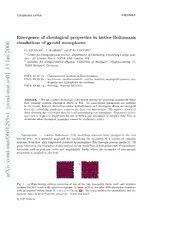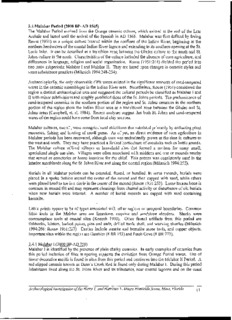
Christine Andersen Controls of seafloor depth on hydrothermal vent PDF
Preview Christine Andersen Controls of seafloor depth on hydrothermal vent
Controls of seafloor depth on hydrothermal vent temperatures - prediction, observation & 2D finite element modeling Christine Andersen Master thesis in geology at Lund University - Lithosphere and Paleobiosphere Sciences, no. 267 (45 hskp/ECTS) Department of Earth- and Ecosystem Sciences Division of Geology Lund University 2010 Controls of seafloor depth on hydrothermal vent temperatures - prediction, observation & 2D finite element modeling Master Thesis Christine Andersen Department of Earth & Ecosystem Sciences Division of Geology Lund University 2010 Contents 1 Introduction & Aim ........................................................................................................................................... 5 2 Background ....................................................................................................................................................... 5 2.1 Discovery of seafloor venting 6 2.2 Fundamental characteristics of submarine hydrothermal systems 8 2.3 Seafloor sulphide deposits 10 2.4 Equation of State of seawater 12 2.5 Investigation methods & modeling approaches 13 3 Mathematics & The model .............................................................................................................................. 14 3.1 Physical processes 15 3.1.1 Darcy’s law for fluid flow 15 3.1.2 Conservation of mass 15 3.1.3 Heat transport 16 3.2 The model 17 3.2.1 Governing equations 17 3.2.2 Numerics 18 3.2.3 Model assumptions & Set up 19 4 Results ............................................................................................................................................................... 22 4.1 Observed vent temperatures 22 4.2 Comparison of predicted & observed vent temperatures 22 4.3 Porous convection modeling 23 4.3.1 Seafloor depth & Vent temperatures 23 4.3.2 Decreased heat supply 29 4.3.3 Increased distance to heat source 32 4.4 Global conductive heat flow data 33 5 Discussion.......................................................................................................................................................... 34 5.1 Discrepancy of prediction & observation 34 5.1.1 Lower than predicted temperatures 34 5.1.2 Higher than predicted temperatures 35 5.1.3 Further controls on vent temperatures 35 5.2 Implications from conductive heat flow measurements 36 5.3 Model limitations & outlook 36 6 Conclusions ....................................................................................................................................................... 37 Acknowledgements .............................................................................................................................................. 37 References ............................................................................................................................................................. 38 Appendix I - Abbreviations, symbols, glossary & units ................................................................................. 41 Appendix II - Porous convection source code (Matlab) .................................................................................... 42 Cover Picture: Hydrothermal convection plumes in the oceanic crust in a system below the seafloor located at 1500m depth, 165 years after the start of the numerical simulation. Controls of seafloor depth on hydrothermal vent temperatures - prediction, observation and 2D finite element modeling CHRISTINE ANDERSEN Andersen, C., 2010: Controls of seafloor depth on hydrothermal vent temperatures - prediction, observation and 2D finite element modeling. Examensarbeten i geologi vid Lunds universitet, Nr. xxx, 47 pp. 45 points. Abstract. Circulation of hot hydrothermal fluids in fractures and faults of the oceanic crust is driven by tempera- ture and pressure gradients. Fluid discharge is focused to vertical structures, black or white smoker chimneys on the seafloor. Hydrothermal vent temperatures should hypothetically be directly related to water depth. The boiling point of sea water increases with depth and ends at the critical point, ~298.5 bar and ~407°C, which equals a sea- floor depth of ~3000m. As most vent fields are located at a shallower depth, fluid temperatures are expected to fol- low the boiling curve during ascend to the seafloor. Aim of this work is to identify regions of hydrothermal activity that follow or do not follow the boiling curve as well as explanations for possible deviations. Moreover it is aimed to make predictions on hydrothermal activity in regions, where no vent systems have yet been discovered. In this work, predicted vent temperatures are computed from bathymetry data and the Equation of State for sea- water (3.2% NaCl) and compiled into maps and diagrams. Poor correlation between prediction and global vent tem- peratures monitored on the seafloor show that those cannot be directly calculated from the boiling curve. All vent fluid temperatures lie in subcritical regions, most below the boiling curve. Higher than expected vent temperatures are rarely found. In order to examine physical processes that could explain the discrepancy between measured and predicted vent temperatures, a numerical model for porous convection in submarine hydrothermal systems with a finite element formulation for 2D compressible fluid flow is developed in Matlab. The model simulates the evolution of hydro- thermal circulation in a cross sectional area along a Mid Ocean Ridge axis with a bottom heat source of 1000°C located 1000m below the sea floor. Modeled vent temperatures for various depths agree well with the boiling curve, which confirms it as an upper temperature boundary. Moreover, the simulations demonstrate that a bottom heat supply of a decreased temperature (300°C – 800°C) results in significant lower than predicted vent temperatures. Also mixing of hot hydrothermal fluids with different amounts of cold seawater in the oceanic crust near the sea- floor can explain temperature deviations below the boiling curve. The major part of compiled vent temperatures below the boiling curve can be explained by mixing with up to 40% seawater. Calculations from global conductive heat flow data imply a high possibility of submarine hydrothermal activity in the southern hemisphere of all three major oceans: on the Southern Mid-Atlantic Ridge, the entire South-Eastern Indian Ocean Ridge as well as on the South-Western East Pacific Rise. Keywords: porous convection, compressible fluid flow, boiling, mixing, low heat supply, conductive heat flow Christine Andersen, Department of Geology, GeoBiosphere Science Centre, Lund University, Sölvegatan 12, SE- 223 62 Lund, Sweden. email: andersen.christine.s@gmail.com Controls of seafloor depth on hydrothermal vent temperatures - prediction, observation and 2D finite element modeling CHRISTINE ANDERSEN Andersen, C., 2010: Controls of seafloor depth on hydrothermal vent temperatures - prediction, observation and 2D finite element modeling. Examensarbeten i geologi vid Lunds universitet, Nr. xxx, 47 pp. 45 poäng. Sammanfattning. Cirkulationen av heta hydrotermala lösningar i sprickor och förkastningar i oceanskorpan drivs av temperatur- och tryckgradienter. Utflödet på havsbotten fokuseras till vertikala strukturer, s.k. svarta och vita rökare. Den hydrotermala lösningens temperatur ska hypotetiskt kunna relateras direkt till vattendjupet. Havsvattnets kokpunkt ökar med djupet till dess att kokpunktskurvan slutar vid den kritiska punkten, ~298.5 bar och ~407°C. Detta motsvarar ett djup av ~3000m. Eftersom de flesta utflödesområden ligger på mindre djup, antas lösningarnas temperatur följa kokpunktskurvan på sin väg mot havsbotten. Prognosticerade utflödestemperaturer är i detta arbete beräknade från batymetriska data och kokpunktskurvan för havsvatten (3.2% NaCl) och därefter sammanställda till kartor och diagram. Korrelationen mellan prognosticerade och uppmätta globala utflödestemperaturer är dålig och visar att de senare inte kan förutsägas direkt från kokpunktskurvan. De flesta uppmätta temperaturerna ligger i det subkritiska området under kokpunktskurvan. Högre temperaturer än förväntat hittas sällan, inga når överkritiska förhållanden. Arbetets syfte är att identifiera regioner av hydrotermal aktivitet som följer eller som inte följer kokpunktskurvan samt att hitta förklaringar till möjliga avvikelser. Dessutom syftar arbetet på att förutsäga hydrotermal aktivitet i regioner där den inte har hittats än. En numerisk modell för porös konvektion i submarina hydrotermala system har utvecklats i Matlab för att studera de fysikaliska processer, som kan förklara diskrepansen mellan mätta och förutsagda utflödestemperaturer. Modellen är en finita-element modell i 2D för kompressibelt flöde. Den undersöker utvecklingen av den hydrothermala cirkulationen i en tvärsnittsyta av en mittocean rygg med en 1000°C värmekälla belägen 1000m meter under havsbotten. Modellerade utflödestemperaturer för olika djup stämmer väl överens med kokpunktskurvan och bekräftar att denna är en övre temperaturgräns. Dessutom demonstrerar simuleringarna att en värmekälla med lägre temperatur (300°C – 800°C) resulterar i signifikant lägre utflödestemperaturer. Även blandning av varma hydrotermala lösningar med olika mängder av kallt havsvatten i oceanskorpan nära hasvbotten kan förklara temperaturavvikelserna. Majoriteten av de undersökta utflödestemperaturerna, som ligger under kokpunktskurvan, kan förklaras med inblandning av upp till 40% havsvatten. Beräkningar från globala konduktiva värmeflödesmätningar tyder på en hög sannolikhet för submarin hydrotermal aktivitet i alla stora oceaner på den södra hemisfären: på den södra Mittatlantiska Ryggen, hela sydöstra ryggen i Indiska oceanen och på sydvästra East Pacific Rise. Nyckelord: porös konvektion, kompressibelt flöde, kokning, blanding, lågtempererad värmekälla, konduktivt värmeflöde Christine Andersen, Department of Geology, GeoBiosphere Science Centre, Lund University, Sölvegatan 12, SE- 223 62 Lund, Sweden. email: andersen.christine.s@gmail.com 1 Introduction & Aim Aim Economically interesting minerals and metals are situ- This work aims at constraining the relationships be- ated at the seafloor of active plate margins around the tween water depth and vent temperatures of submarine globe. Submarine hydrothermal activity is intimately hydrothermal systems on a global scale. Key objec- related to the formation of such Submarine Massive tives of this project are: Sulphide (SMS) deposits. Exceptional high ore grades of up to 6.7 ppm Au and 1000 ppm Ag for precious to give a background on submarine hydrothermal metals have been reported locally (Herzig and Han- processes and associated mineral deposits nington, 1995). Active black and white smokers are to identify seafloor hydrothermal vent fields that primarily studied at Mid Ocean Ridges (MORs). Hot follow or do not follow the described relationship hydrothermal fluids, enriched with dissolved minerals between water depth and vent temperature and metals are expelled with high flow rates of up to meters per second, at these submarine hot springs to find explanations for vent temperatures to devi- (Spiess et al, 1980). The contact of hot hydrothermal ate from the boiling curve fluids with cold seawater causes dissolved metals to to make predictions on vent temperature and loca- precipitate sulfide minerals around the vent chimneys tion in settings, where no vent systems have yet as well as to deposit metalliferous sediments on the been found seafloor around the vent sites (e.g. Marques et al., 2007). In the close future, the first submarine SMS Answers to these questions are achieved by compila- deposits will be mined outside Papua New Guinea by tion of available vent field data on location, tectonic Nautilus Minerals (Nautilus Minerals, 2010). If sub- setting, and temperature into global maps and dia- marine ore deposits will become long scale future ore grams. Predicted vent temperatures at plate boundaries resources for mankind it is crucial to understand con- are computed from global bathymetry data and the trolling mechanism increasingly detailed as well as to Equation Of State (EOS) for seawater and then com- accomplish a sustainable exploitation with least possi- pared to vent data observed on the seafloor. A 2D fi- ble environmental impact (e.g. Herzig, 1999; Rona, nite element numerical model for porous convection is 2008). developed in Matlab. The model simulates the evolu- Sighting of the first active vent sites with a tion of hydrothermal circulation in the oceanic crust manned submersible was in the late 1970‟s (Corliss et and is used to study physical processes that may lead al., 1979; Spiess et al., 1980). Thus, research of sub- vent temperatures to deviate from the boiling curve. marine hydrothermal systems is still rather young and many fundamental questions remain to be answered. Direct investigations of hydrothermal vent sites with 2 Background deep diving instruments are powerful tools for data collection which now become increasingly precise. As Lowell et al. stated in 1995, the research on subma- Disadvantages are high costs and time. A complemen- rine hydrothermal systems is young compared to other tary way of learning about hydrothermal processes in areas of geosciences. It is an interdisciplinary field the oceanic crust is to create numerical models. From with fast scientific progress, which both makes it an modeling we can learn about fundamental thermody- attractive and challenging topic to study. namic processes of hydrothermal fluid convection be- A lot of information is available on hydrother- neath the seafloor. Mechanisms that directly control mal systems located at MORs, where new oceanic mineral and metal deposition around vent sites at the lithosphere is being produced under extensional tec- seafloor like fluid flow, heat and mass flux as well as tonic conditions, (e.g.Coumou et al., 2008; Marques et flow pattern can be simulated (e.g. Coumou et al., al., 2007; Wilcock and Delaney, 1996). Such thermal 2008; Schardt and Large, 2009). springs are also found on volcanic arcs associated with Fluid temperature is a key factor that controls subduction zones as e.g. on the Mariana Arc (Resing et the possible amount and type of dissolved minerals al., 2007) and in hot-spot related settings, e.g. on Ha- carried in hydrothermal fluids. Vent temperatures waii (Fig.1). Submarine hydrothermal circulation is should hypothetically be directly related to water efficient in transporting energy and mass through the depth. The boiling point of sea water increases with interface between oceanic crust and the ocean. It is depth and the critical end-point is at ~407°C and estimated to be responsible for ~30% of the global ~298.5 bar, which approximately corresponds to a heat transport through the ocean floor (Hutnak et al., depth of ~3000m (Bischoff and Rosenbauer, 1988). As 2008; Lowell et al., 1995). Moreover circulating practically all known vent fields are located at shal- hydrothermal fluids at mid-ocean ridges are calculated lower water depth, boiling should have a major control to stand for ~25 % of Earth`s total heat loss from the on vent temperatures. Rising hot and potentially super- interior (Coumou et al., 2008; Lowell et al., 1995). critical hydrothermal fluids are expected to follow the Except that studying submarine hydrothermal boiling curve on their way up to the seafloor, so that systems reveals many answers on fundamental ques- the vent temperatures should equal the predicted boil- tions in various areas of geosciences, society can di- ing temperature of seawater. rectly benefit from it. A strong motivation to investi- 5 Fig. 1. Global hydrothermal vent sites discovered until today in various tectonic settings with their exclusive economic zones and major Mid Ocean Ridges and subduction trenches associated with volcanic arcs (InterRidge, 2010). gate the character of these systems is their intimate (e.g. Mitra et al., 1994) smokers on the ocean floor connection to the formation of Volcanic Massive Sul- shed some light on many, until then, unresolved ques- phide (VMS) ore deposits. An essential part of the tions but simultaneously generated most likely even base and precious metals produced today are mined more new ones. Areas to be named that gained a lot of from VMS deposits on land (Herzig, 1999). Numerous new insights through the discovery of hot springs in questions about Submarine Massive Sulphide deposits the deep sea are e.g. biology and chemistry: excep- (SMS) regarding e.g. ore grades, distribution, eco- tional faunal communities have been monitored nomical feasibility, environmental impacts and mining around the vent chimneys that utilize chemosynthetic techniques yet remain unanswered. processes in order to survive in the deep ocean far In the following, first an outline on the scien- away from any source of light (Lowell et al., 1995). tific advances leading to the discovery of submarine Taking into account the large quantity of heat expelled hydrothermal activity will be given in 2.1. Definition into the ocean by hydrothermal venting it was now and fundamental mechanisms of submarine hydrother- possible to make more accurate global heat flux esti- mal systems will be described in 2.2. SMS deposits mates (Hutnak et al., 2008). The detection of active and their potential as future ore resource for society submarine volcanism at oceanic spreading centers also will be sketched in 2.3. Section 2.4 evaluates con- updated the understanding of plate tectonics and its straints of the EOS for seawater on hydrothermal sys- driving forces as e.g. mantle convection processes tems. In the final background section investigation (Wilcock, 1998). Moreover until the discovery of sub- methods for submarine hydrothermal systems will be marine hydrothermal systems, VMS deposits were outlined briefly as well as different mathematical mod- merely known and mined from sites on land. In the eling approaches (2.5). field of ore geology a new understanding about the origin of VMS deposits could be derived from the dis- covery of submarine hot springs. For applied geology, 2.1 Discovery of seafloor venting the detection of submarine VMS deposits associated The first sighting of submarine hydrothermal vent sites with hydrothermal vents thus meant an enormous step in the late 1970‟s at the Galapagos Rift (Corliss et al., in the assessment of marine ore deposits and their eco- 1979) and the East Pacific Rise (Spiess et al., 1980) nomic potential (Herzig and Hannington, 1995). was a remarkable step for many fields of marine sci- In their paper published in 1995, Lowell et al. ences. Like for many outstanding scientific findings, reviewed in detail the development of scientific ad- the discovery of black (Fig. 2a) and white (Fig. 2b) vances that resulted in the discovery of submarine 6 thermal springs on MOR crests in the end of 1970. It of an aging and cooling oceanic plate created at a was a complex interplay of insights from various fields MOR (Sclater et al., 1971), lead to first speculations of geosciences that lead to the final discovery. Early about the connection between heat flow, mantle con- evidence was indirect, coming from e.g. calculations vection and later even about fluids that circulate of heat flux through the ocean floor in the mid- to end through the oceanic crust. Crustal depth and age of the 1960‟s. About a decade later the first submarine seafloor were used as proxies for heat flow. It soon hydrothermal vent sites were sighted with geophysical became clear that predictions made by heat-flow cal- investigation methods and deep-diving research ves- culation did not fit the conductive heat flow data ac- sels. quired from the seafloor. Conductive heat flow meas- ured in a certain distance of MORs was always too Indirect evidence for submarine hydrothermal activity low. Talwani et al. in 1971 were one of the first to An odd incidence might have impeded a much earlier suggest that this incongruity might be explained by discovery of submarine hydrothermal activity at the seawater circulating through the oceanic crust, causing ocean floor. The very first indication of thermal advective heat loss. They present heat flow anomalies springs in the deep ocean can be traced back to as in certain distances to the ridge axis monitored through early as 1948. During the Swedish Deep-Sea Expedi- geophysical surveys on Iceland. A detailed study on tion with the research vessel „Albatross‟ (Pettersson, the thermal balance of the Juan de Fuca Ridge was 1948), anomalous temperatures and salinities were published in the following year by Lister (1972). There monitored in the Red Sea. Yet, at that time this was it is explicitly stated that circulating hydrothermal flu- overlooked because geologist G. Arrhenius, it is said, ids have much greater influence on the thermal balance was off board to his marriage in Stockholm. Not until of MORs than conductive cooling processes. Lister much later, in the 1960‟s, the Red Sea anomalies were (1972) also stated that hydrothermal springs were ex- noticed and reinvestigated on transit during the Inter- pected to be found at ridge crests. national Indian Ocean Expedition (Deacon, 1960; Dea- In the late 1960- early 70‟s other research was con, 1964). done which indirectly can be linked to the subsequent Lowell et al. (1995) portray how conductive discovery of seafloor hydrothermal systems. This is heat flow studies of the seafloor coupled with models sketched by Lowell et al. (1995): ophiolites, ancient Fig. 2a top left. Black smoker hydrothermal site with 350°C exiting fluids that are highly enriched in minerals and metals, at 2600m seafloor depth on the East Pacific Rise 21N°, moni- tored in 1979 with Alvin (Herzig, 2003). Fig. 2b top right.. White smoker chimneys at 1700m depth in the Lau basin outside of Tonga in the South Pacific, monito- red with the french deep diving vessel Nautilus. The exiting hydrothermal fluid is enriched in light mineral phases like barite, anhydrite and SiO (Herzig, 2003). 2 Fig. 2c left. Diffuse low temperature vent site with 21°C warm exiting hydrothermal fluid, monitored with the american deep diving vessel Alvin on the Northern East Pacific Rise during the Endeavour-Axial Geochemistry & Ecological Re- search cruise. Also some white, worm-like vent organisms can be seen (EAGER, 2009). 7 oceanic crust emplaced on the continents by plate tec- along the axial ridge. The rising hydrothermal fluids tonic processes (e.g. Gomez Barreiro et al., 2010) were were mixing with the cold seawater with flow rates of investigated in the field (e.g. in Oman and on Cyprus), 2-10 cm/sec. The vent sites occurred at depth of about water-rock interactions were studied in the laboratory 2500m and are described as being roughly circular as well as mineralogy and chemistry of altered sea- with a dimension of 30 – 100m in diameter. Hydro- floor basalts and metalliferous sediments were exam- thermal plumes were monitored up to 150m above the ined. vent sites, were temperature anomalies of 0.1°C could still be detected. Also sulfide containing mounds of Direct evidence - discovery of the first vent sites hydrothermal mineral deposits in sediment covered Most effective strategies for exploring submarine areas south of the ridge axis were examined. Moreover hydrothermal systems are surveys starting from a re- extraordinary biological communities were discovered gional scale and moving towards more local investiga- around the hot springs: these are able to survive in the tions later on. Nevertheless, early detection of active absence of light using the energy from water-rock in- hydrothermal fields, which later lead to sighting of the teractions and chemosynthetic bacteria. first vent sites, contained a large moment of chance A year after the expedition by Corliss et al. (Lowell et al., 1995). During the 1960‟s, the Red-Sea (1979), another cruise was done were Alvin was oper- hydrographical anomalies that randomly had been ating and their findings could be confirmed. Beyond monitored in 1948 (Pettersson, 1948), were reinvesti- that, through various geophysical investigations, Spi- gated. Hydrothermal brines containing suspended min- ess et al. (1980) proved the existence of submarine erals and metals were detected as well as metalliferous springs, venting fluids of much higher temperatures sediments deposited in basins along the ridge axis. By than the previously known warm springs. At the East that time hydrothermal activity was still believed to be Pacific Rise ridge axis north of the Galapagos Rift an exceptional feature at that specific locality, linked they sighted hot fluids (380°C +/- 30°C) loaded with to an early stage of ocean basin opening (Lowell et al., dark metallic matter, escaping from black chimneys at 1995). During a Transatlantic- Geotraverse project in high speed of meters per second. They also found sul- the early 1970‟s another active hydrothermal field fide minerals distinctly zoned around the black smoker (TAG-field) was discovered on the Mid Atlantic Ridge chimneys. (MAR) at 26°N by chance, through the recovery of The exceptionally deepest vent at almost low temperature hydrothermal minerals by dredging 5000m depth at the seafloor on the Cayman trough in on the seafloor. This was followed by measurements the Mexican Gulf was discovered recently, in July of of anomalous water temperatures at the same locality 2010 (Fig. 1). Until today ~550 active hydrothermal (Rona, 1978). In the same period hydrothermal activity vent sites have been listed (Fig.1) (InterRidge, 2010). was discovered at the Galapagos Spreading Centre An excellent overview of until now discovered hydro- (Weiss et al., 1977) and the East Pacific Rise (EPR) thermal vent sites on the seafloor can be gained from a (Larson and Spiess, 1968) by deep-tow sonar tech- global vent data set available from the InterRidge data- nique. When hydrothermal vent sites were still not base (InterRidge, 2010). The data set can be loaded localized, Weiss et al. (1977) were able to proof the with Google Earth, so that detailed information about existence of buoyant hydrothermal plumes at the Gala- vent location, temperature and discovery can be ex- pagos Rift. These were recognized as seawater dis- plored interactively. charging from fissures in the young oceanic crust, a few meters above the oceanic spreading axis. Also a strong helium anomaly, characteristic for hydrother- 2.2 Fundamental characteristics of sub- mal brines, was detected during the investigation of marine hydrothermal systems hydrothermal plumes at the Galapagos Rift (Lupton et An area of hot or warm fluids, circulating below al., 1977). They proved the existence of fluids with a Earth‟s surface in both lateral and vertical direction is very high 3He/4He ratio which can be explained by called a hydrothermal system (Pirajno, 1992). This hydrothermal circulation processes which transport basic definition can naturally be extended to levels of 3He from the mantle to deep ocean water. Based on the higher complexity, dependent on what is required in findings at the Galapagos Rift a research diving pro- each context. Hydrothermal systems mirror a complex ject with a manned submersible was planned. interplay of different components, which is challeng- In 1979, during 24 dives with the submersible ing to present in simplified models. Here, nature and Alvin, Corliss et al. sighted four low-temperature sub- fundamental processes of sub-seafloor hydrothermal marine thermal springs on the Galapagos Rift. The systems, mainly at MORs will be addressed with a dives were documented by pictures taken with a towed focus on associated mineral deposits. camera as well as samples of rock and hydrothermal fluids. Corliss et al. (1979) describe how a shimmer- Fundamental processes ing, milky white fluid could be observed just above the The two most essential components of hydrothermal seafloor, rising from openings in the bottom pillow systems are: a heat source and a fluid phase (Pirajno, lava. This showed to be warm hydrothermal fluids 1992). At MORs, new oceanic lithosphere is produced venting at maximum temperatures between 10° - 17° C by igneous and tectonic processes with the magma 8 chamber at depth being the heat source that drives Spatial dimensions hydrothermal circulation. The fluid phase is domi- Spatial dimensions of hydrothermal fields and associ- nantly derived from seawater (e.g. Fornari and Em- ated features are highly variable. Systems are reported bley, 1995). Circular convection of hydrothermal flu- from a wide range of depths: a mean depth of around ids is driven by heat and pressure gradients causing 2km is common, but systems are also found at shal- cold, dense fluids to migrate downwards, be heated at lower depth of <100m close to continental platforms depth to become more buoyant and rise back towards (Suárez-Bosche et al., 2005) and as deep as 4km, the surface (Fig. 3). A discharge and a recharge zone which exceeds the depth for critical boiling conditions. can be found (e.g. Alt, 1995; Hannington et al., 1995). Hydrothermal vents are roughly circular with a dimen- In submarine systems, fluid discharge is focused on sion of tens of meters in diameter, about 30 – 100m vertical structures, black or white smoker chimneys, (e.g. Corliss et al., 1979). Black and white smokers located in the axial region or at the flanks of MORs. mostly occur in fields consisting of several vent sites. This correlates to discharge features in form of e.g. hot The discharging chimneys are often arranged in a pools or geysers of hydrothermal systems on land chain (e.g. Fig. 2b) (e.g. Coumou et al., 2008). In the (Suárez-Bosche et al., 2005). In seafloor-systems, fluid review paper of Lowell et al. (1995), vent field areas recharge takes place in form of seawater traveling are listed with a size ranging from 3×103m2 to 105m2. down several km into the oceanic crust along high They also describe varying heights for the chimneys of permeability pathways like faults and fractures (e.g. ~20-45m. Venting is focused to narrow openings of a Alt, 1995; Pirajno, 1992). few cm. Convection cells extend laterally to several The temperature of fluids exiting at active vent km, seawater can penetrate down to 5-10km (Kuehn, sites is a characteristic parameter for the classification 2004). The time between a fluid entering and being of hydrothermal systems. Fornari and Embley (1995) discharged from a hydrothermal system is estimated distinguish low-T systems with temperatures of to only a few years (Pirajno, 1992). The thermohaline <200°C and high-T systems of 200°C - 400°C. circulation of the ocean system is affected by hydro- thermal plumes rising hundreds of meters above active Fig. 3. Fundamental features and processes of submarine vent sites and spreading up to thousands of kilometers hydrothermal systems. Temperature and pressure gradients in a lateral direction (Suárez-Bosche et al., 2005). between the heat source and the seafloor drives hydrothermal fluid circulation (WHOI, 2010). Temporal evolution The birth of a new hydrothermal system is still not very well understood. Seafloor hydrothermal venting might start with a sudden displacement of a large hydrother- mal plume related to increasing volcanic activity along the axial rift (Hannington et al., 1995). A single submarine vent typi- cally undergoes different stages of venting, in which vent fluid temperature and vent- ing style vary (Fig. 2a-c) (Hannington et al., 1995; Pirajno, 1992). Both can vary significantly depending on e.g. tectonic setting and seafloor spreading rate. A young hydrothermal system often begins with diffuse, low-temperature venting (<10°C-50°C) (Fig. 2c) that slowly trans- forms into a white smoker. Fluid tempera- tures between about 100°C and 300°C are favorable for white smoker hydrothermal activity. During continuous hydrothermal discharge the fluid pathway becomes suc- cessively more sealed with precipitated hydrothermal minerals. This leads to a more focused and narrow fluid channel which prevents the hot, rising fluids from extensive mixing with colder seawater until the system has evolved into a high tem- perature, black smoker (Fig. 2c) (Pirajno, 1992). Diffuse hydrothermal flow can also occur in the final stage of black- smoker venting just prior to its collapse and at mar- 9
Description:The list of books you might like

The Strength In Our Scars

Shatter Me Complete Collection (Shatter Me; Destroy Me; Unravel Me; Fracture Me; Ignite Me)

Can’t Hurt Me: Master Your Mind and Defy the Odds

Believe Me
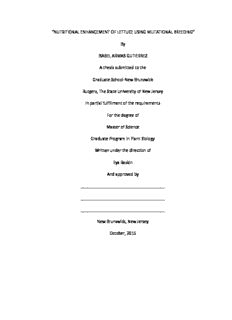
By ISABEL ARMAS GUTIERREZ A thesis submitted to the Graduate

By Irina Kossovskaia, MD, PhD, DNM
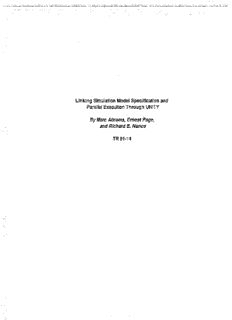
By Marc Abrams, Ema-st Page

NASA Technical Reports Server (NTRS) 20110015537: Historic Emissions from Deforestation and Forest Degradation in Mato Grosso, Brazil: 1. Source Data Uncertainties
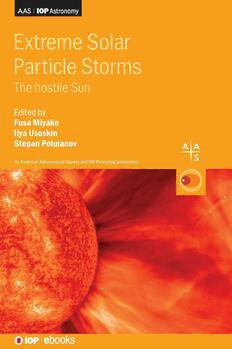
Extreme Solar Particle Storms: The Hostile Sun

C linguaxe admin Fut

Overview of Boundary Layer Transition Research in Support of Orbiter Return To Flight

DTIC ADA453406: Lipoxygenase, Angiogenicity, and Prostate Cancer Radioresistance
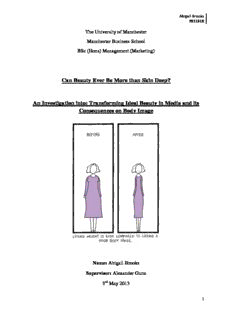
Can Beauty Ever Be More than Skin Deep?

by Pablo-Alejandro Quinones A dissertation submitted in partial fulfillment of the requirements for

Learning from Iraq - Counterinsurgency in American Strategy (2006)

Project Theme Needfinding Arduino + Electronics

can be found here - Australian Nanotechnology Alliance

personalsafety

Handbook of olfaction and gustation, Volume 236

Boston College magazine


